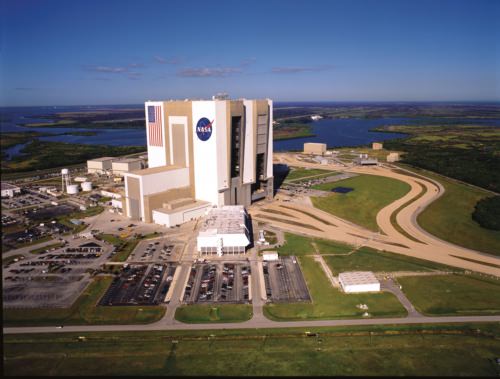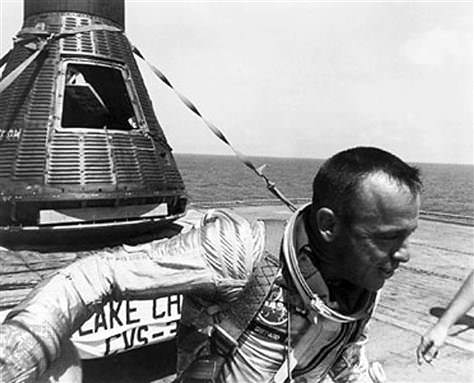On July 1, 1962, the Launch Operations Center in Florida officially became operational. The name was later changed to John F. Kennedy Space Center in honor of the president and his vision of Americans visiting the Moon. This video looks back at the many launches and space exploration highlights that occurred at KSC, so enjoy this look back from where many journeys to space began. If you are going to be near KSC during the US’s 4th of July holiday, NASA is hosting some special events in commemoration of the 50th anniversary. The KSC Visitor Complex is offering rare behind-the-scenes tours for its 50th anniversary year, including one taking visitors inside the massive, 525-foot-tall Vehicle Assembly Building, where the Apollo rockets and space shuttles were assembled.
You can find out more info about the events at the KSC Visitor’s Center website
China to Send Its First Woman to Space on June 16
China will launch a three-person crew on Saturday, June 16, 2012 at 10:37 UTC (6:37 a.m. EDT) on board a Shenzhou 9 spacecraft, heading to the Tiangong 1 spacelab. The crew includes Liu Yang, the first female Chinese taikonaut. With her will be Jing Haipeng, the commander and a veteran of two other spaceflights and Liu Wang. This will be the first manned docking to the Tiangong 1 (Heavenly Palace), which was launched in September 2011.
The Shenzhou 9 will launch from the Jiuquan Space Launch Center in the Gobi desert in western China.
Yang is a 33-year-old fighter pilot and said during a broadcast interview, “From day one I have been told I am no different from the male astronauts…I believe in persevering. If you persevere, success lies ahead of you.”
Liu joined the taikonaut training program in May 2010 and was selected as a possible candidate for the docking mission after she excelled in testing, according to the Xinhua news agency.
She initially trained as a cargo pilot and has been praised for her cool handling of an incident when her jet hit a flock of pigeons but she was still able to land the heavily damaged aircraft.
At a press conference, the three taikonauts were behind a glass wall before a small group of hand-picked journalists. They said the manual docking was a “huge test,” but that they had rehearsed the procedure more than 1,500 times.
“The three of us understand each other tacitly. One glance, one facial expression, one movement, we understand each other thoroughly,” said Jing.
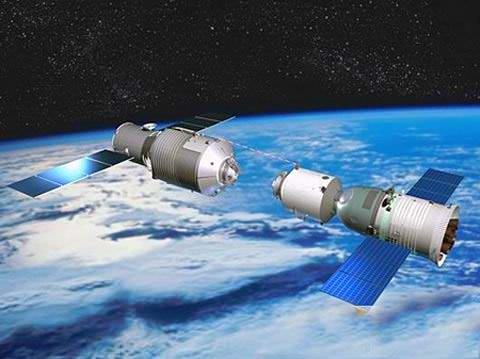
Once Shenzhou 9 reaches the vicinity of Tiangong 1, the crew will perform a manual docking, but the Chinese space agency has said future missions will have automated dockings.
Some reports have indicated the Shenzhou spacecraft is designed with a common docking system that would allow it to dock with the International Space Station in the future should China be invited to visit.
Once on board the Taingong 1, the crew will do some medical research and conduct other research including monitoring live butterflies and butterfly eggs and pupae.
China has said they hope to add more modules to their space station, with a final version of it built by 2020. A white paper released last December outlining China’s ambitious space program said the country “will conduct studies on the preliminary plan for a human lunar landing.”
Lead image caption: China’s astronauts Jing Haipeng (C), Liu Wang (R) and Liu Yang meet with media in Jiuquan, China on June 15, 2012. The three astronauts will board Shenzhou-9 spacecraft on Saturday for China’s first manned space docking mission. Credit: Xinhua/Wang Jianmin
Second image caption: An artists rendering of the Tiangong-1 module, the first part of China’s space station. To the right is a Shenzhou spacecraft, preparing to dock with the module. Image Credit: CNSA
Sources: PeopleDaily, AFP, SpaceRef.
Spiral Seen Over the Middle East Likely Russian Missile
Remember the Norway Spiral back in 2009 and the Australian Spiral in 2010? On June 7, 2012 there was another swirling spiral of light, this time see in the skies over the Middle East. People across the region reported seeing a “UFO” and soon videos began showing up on YouTube.
The strange sight has been confirmed to be a Russian ballistic missile test of the Topol ICBM from the Kapustin Yar firing range near Astrakhan in southern Russia.
Continue reading “Spiral Seen Over the Middle East Likely Russian Missile”
Beautiful Night Launch for Ariane 5
Practice your French counting skills and enjoy a beautiful night launch all in one fell swoop! An Ariane 5 rocket launched last night (May 15 at 22:13 GMT) from Europe’s Spaceport in French Guiana, sending two telecommunications satellites to space. The satellites, JCSAT-13 and Vinasat-2, were successfully and accurately injected into their transfer orbits about 26 minutes and 36 minutes after liftoff, respectively. This was the 62nd Ariane 5 launch, and the second this year. In March, an Ariane 5 rocket sent the ATV-3 “Edoardo Amaldi” to the International Space Station.
The View From Freedom 7
51 years ago today, on May 5, 1961, NASA launched the Mercury-Redstone 3 rocket carrying Alan B. Shepard, Jr. aboard the Freedom 7 capsule. Shepard successfully became America’s first man in space, making a brief but historic suborbital test flight that propelled American astronauts into the space race of the 1960s.
The video above is made from photographs taken by a film camera mounted to the Freedom 7 spacecraft and scanned by archivists at Johnson Space Center. It shows the view from Freedom 7 as the Redstone rocket launched it into space, getting an amazing view of Earth’s limb and the blackness beyond before falling back to splash down in the Atlantic.
The video is made from the entire film reel, so at the end there’s also some shots of a light experiment inside the spacecraft. (View the individual scans at ASU’s March to the Moon website here.)
What’s amazing to realize is that, at this point in time, the space surrounding our planet was a very empty place. This was a time before communication and weather satellites, before GPS, before Space Station and space shuttles — and space junk — and student-made weather balloon videos. Just 51 years ago low-Earth orbit was a new frontier, and guys like Shepard (and Gagarin and Glenn, etc.) were blazing the path for everyone that followed.
Even though images of Earth from space are still amazing to look at today, seeing these photos reminds us of a time when it was all just so very new.
Read more about Shepard and the MR-3 launch here.
Images and video: NASA/JSC/Arizona State University
[/caption]
What a Space Shuttle Launch REALLY Sounded Like
When I attended my first space shuttle launch, the most amazing thing about the whole launch experience may have been the sound. Being there at Kennedy Space Center is nothing like seeing it on television. When the sound waves travel across the 5.6 km (3.5 miles) from the launchpad to the KSC press site, the noise and sound just absolutely overwhelm and engulf you. You don’t only hear and see a space shuttle launch, you *feel* it! I heard astronaut Steve Robinson describe it as “it seems the air just isn’t big enough for the sound.” That sums it up pretty well.
Each launch I attended, I tried to record the crackling and popping of the rockets burning, but my audio equipment was just overwhelmed and the sound was completely distorted. This video is fairly close to what the sound is like, especially if you use a good sound system and turn it up, as the video’s creator, indiegun suggests. He used dozens of different video sources and several audio versions of shuttle launches mixed together to mimic as close to the real experience as he could.
Continue reading “What a Space Shuttle Launch REALLY Sounded Like”
Psychedelics in the Sky: NASA Launches 5 Rockets in 5 Minutes
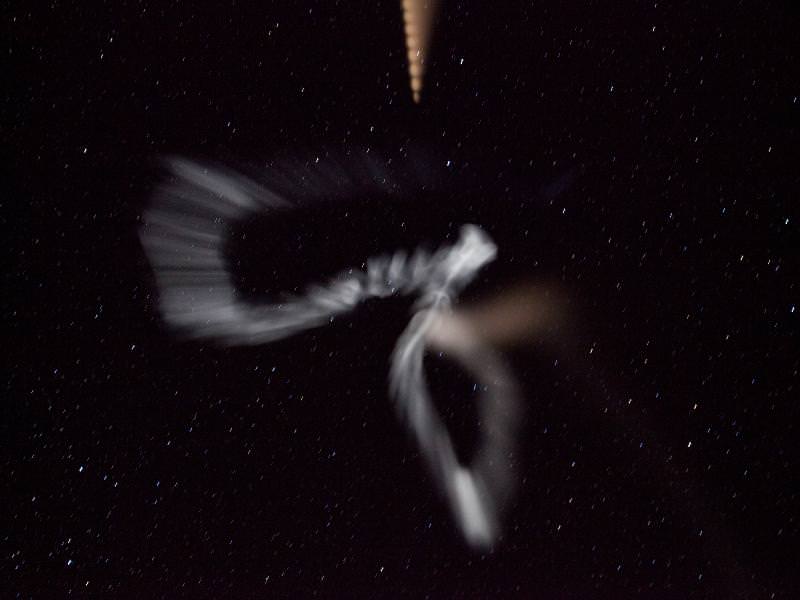
[/caption]
After several days of delays due to weather and technical issues, NASA has now successfully launched five suborbital sounding rockets in five minutes from the Wallops Flight Facility in Virginia as part of a study of the upper level jet stream.
The first rocket was launched at 4:58 a.m. EDT and each subsequent rocket was launched 80 seconds apart.
Each of the rockets released a chemical tracer that created psychedelic-looking clouds at the edge of space, which were reported to be seen from as far south as Wilmington, N.C.; west to Charlestown, W. Va.; and north to Buffalo, N.Y.
The above image was taken from one of the official viewing sites by a NASA photographer; below is an image taken by John Anton from New Jersey, as well as more images from NASA, the video showing all the launches and time-lapse video from twolf1 on Vimeo.
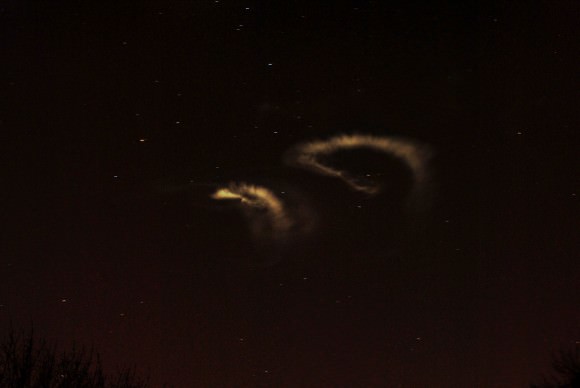
The Anomalous Transport Rocket Experiment (ATREX) is a Heliophysics sounding rocket mission that gathered information to better understand the process responsible for the high-altitude jet stream located 95-105 km (60 to 65 miles) above the surface of the Earth.
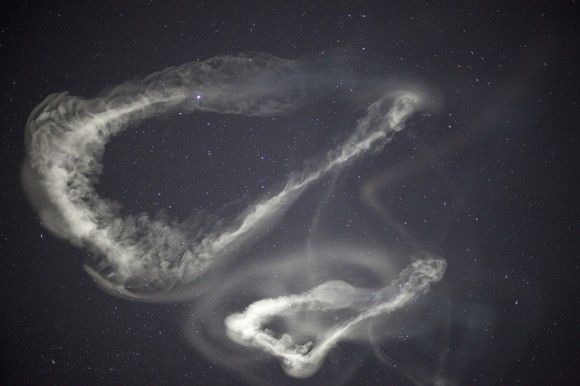
Scientists from the mission had viewing sites at three locations: the launch site in Virginia, the Rutgers Marine Field Station in Tuckerton, N.J., and the U.S. Army Corps of Engineers at Duck, N.C. Clear skies at all three locations were a prerequisite for the rockets to be launched.
The sounding rockets were two Terrier-Improved Malemutes , two Terrier-Improved Orions and one Terrier-Oriole.
Chemical tracers from ATREX rockets launched from NASA’s Wallops Flight Facility in Virginia from twolf1 on Vimeo.
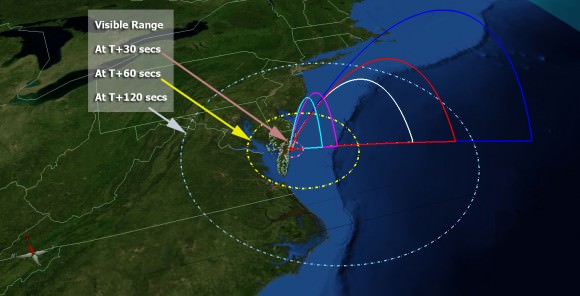
The high-altitude jet stream is higher than the one commonly reported in weather forecasts. The winds found in this upper jet stream typically have speeds of 320 to well over 480 km/hr (200 to over 300 mph) and create rapid transport from the Earth’s mid latitudes to the polar regions. This jet stream is located in the same region where strong electrical currents occur in the ionosphere. It is therefore a region with a lot of electrical turbulence, of the type that can adversely affect satellite and radio communications.
Not only did the rockets release the chemical tracers to allow scientists and the public to “see” the winds in space, but two of the rockets had instrumented payloads to measure the pressure and temperature in the atmosphere at the height of the high-speed winds. NASA will release more information on the outcome of the experiment after scientists have had time to review the data.
See a slideshow of images of the launches on Flickr from NASA
Armadillo Aerospace Rocket Destroyed
Saturday was a perfect day for flying, so we went out to the 100 acres for a boosted hop. We had high expectations for success, since the vehicle had been operating perfectly on all tests so far.
After we loaded up the propellant and pressurized the vehicle, we ran into a problem. When I opened it up to 20% throttle for the warmup it looked like it cleared up fine, but the telemetry was only reading 100C, as if the hot pack hadn?t started heating. We were a long way from the vehicle, so we couldn?t really tell what was going on. I gave it a bunch of slugs of propellant until it finally started going up in temperature properly, but we had blown a lot of propellant out on the ground. Too much.
It finally reached operating temperature and we launched. We had only been operating this engine at hover thrust levels, so we had been a little concerned that it might be rough at full throttle. It was. It flew fine through the roughness, but when it started to throttle down after the two second boost to a 0.5 G positive acceleration level for the stabilization phase, the rough pulses kept passing both above and below the desired acceleration, keeping the engine from throttling down at full speed, resulting in it going a lot higher than intended (just under 600 feet high). It did finally get out of the rough stability zone into clear stabilization, but a couple seconds later, everything got quiet. It ran out of propellant.
It had not hit apogee yet, so the unstable vehicle immediately started rotating, hitting about 50 degrees / second. If the vehicle had been past apogee when it ran out, it probably would have just dropped feet first.
We had telemetry all the way to the time of impact, which matched the video perfectly, landing eight meters from the launch point. The vehicle hit the ground basically sideways, a little tail first. The bottom manway flange broke off the tank, and the 450 pound tank with 180 psi pressure still in it got punted about 200 yards away by the gas release. $35,000 of rocket is now a whole lot of primo Armadillo Aerospace Droppings. There are a few pipe fittings that survived, but that?s about it. Amazingly, even though the on-board camera was destroyed, the tape did survive with only some scuffed sections. It?s a good thing Doom 3 is selling very well?
From analyzing the telemetry (integrating the chamber pressure during the flight), it looks like it wasted two thirds of the propellant on the warmup. If it had lifted off with a normal warmup, it would have landed ok even with the rough throttling, but we would have been in violation of the 15 second burn time limit by the time it landed. There was twice as much propellant loaded as this flight should have required, which I thought was enough to cover any off-nominal conditions, but we obviously should have scrubbed when the warmup didn?t catch after the second or third try. We are going to look into getting a continuous capacitive level sensor next time so we can have a firm no-go line for liftoff. If anyone knows of a peroxide compatible (316 SS / Teflon / viton / eetc) capacitive sensor that runs off of 12v or 5v DC and can handle 300 psi (we may be willing to run past rated pressure if nexessary), let me know. Ideally we would want a 5V or 10V analog out, but we could live with a current sensor, or (with some begrudging) a serial port. We would like to mount it on the bottom of the tank instead of the conventional top location, but we don?t think that will be a problem.
The failure did give us some demonstration data that we always sort of wanted to get (but not that bad). The vehicle is absolutely, positively, NOT going to continue flying nose first when it loses active control. This should be blatantly obvious from the CG, but we had a WSMR engineer pushing us towards a NASA consultant to prove it. When it fails in the air, it just drops like a rock, landing very near the launch site. Rupturing a fiberglass tank doesn?t produce shrapnel, but it does drop kick the tank pretty good. This looked pretty close to an optimal 45 degree launch angle for the tank, so we have a pretty good idea what our safe distances should be.
We probably would have been able to save the vehicle if we had a rocket drawn parachute on board, but we are trying to have a pyro-free vehicle. A pneumatic drogue cannon might have been able to deploy a chute fast enough, but it would be a lot more debatable.
We cut the engine open with the plasma cutter to do a post-mortem, and found what had been causing the engine issues. The combination of the bottom catalyst retaining plate bowing down because it was only welded on the bottom and some catalyst escaping both out the bottom and some out the top (the top screen was burned through in a couple places) left the bottom catalyst not even completely covering the diameter of the engine. When we had the nozzle and cold pack cut off and the engine on its side, you could see right through the hot pack at the top. This explains the apparently clear exhaust at the start while the thermocouple was still reading only 100C, because the thermocouple was fairly short (we used to use a longer one, but the bowing of the retaining plate forced us to use a shorter one so we could still insert it) so it was in a stream around the edges that bypassed most or all of the hot pack catalyst (driving down the highway probably also settled the catalyst on the opposite side from the sensors), while much of the main flow was still being burned. The loosening catalyst is also almost certainly why this engine ?got rough? after we had been using it for a while.
The support plate bowing can be fixed by either making a full depth angle on the sides of the plate so the weld gets full side coverage, or actually weld the plate between two chamber sections, instead of inside a single chamber section. We are making new plates that are made with 1300 quarter inch holes instead of large water jet cut squares that are bridged by screens. This will let us completely avoid the screens altogether, and we are also going to tie the top and bottom plates around the hot pack together by putting quarter inch bolts through some of the quarter inch holes, and welding them together as a unit with the catalyst in between. This should fix the engine behavior.
Everything else operated perfectly, so we still feel good about the general configuration, but we have a number of improvements for robustness and operability that we will be making in the next vehicle we put together. A couple of the necessary items are fairly long lead times, so we are probably grounded for five weeks.
Original Source: Armadillo Aerospace Status Report

